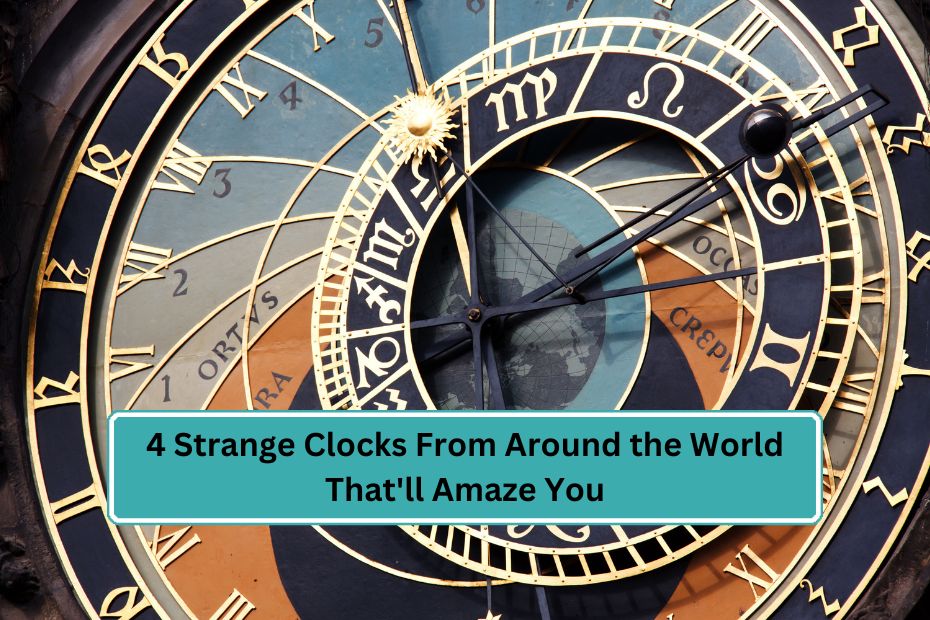Clocks are not just instruments for telling time; they can also be works of art, feats of engineering, and expressions of creativity. From the whimsical to the downright bizarre, strange clocks from around the world never fail to captivate and amaze with their unique designs and functionalities. Let’s take a journey to explore four such extraordinary timepieces that are sure to leave you in awe.
1. The Corpus Clock: A Timepiece of Terror
Origin and Design: The Corpus Clock, located at the University of Cambridge, is unlike any traditional clock you’ve ever seen. Designed by inventor and horologist John C. Taylor, this striking timepiece features a large, gold-plated disc with no hands or numerals.
The Chronophage: Instead of conventional time indicators, the Corpus Clock is adorned with a mysterious creature known as the Chronophage, or “time eater.” This grotesque insect-like figure appears to devour time as it crawls around the perimeter of the clock, creating a mesmerizing but eerie spectacle.
Reaction and Impact: The Corpus Clock has garnered worldwide attention for its innovative design and unconventional approach to timekeeping. While some viewers find its display fascinating, others are unsettled by its ominous symbolism, prompting contemplation about the nature of time and mortality.
2. The Verichron Clock: Time Flies Literally
Introduction to the Verichron Clock: The Verichron Clock, housed in various locations around the world, is known for its unconventional timekeeping mechanism. Instead of traditional clock hands or digital displays, this clock uses live flies to indicate the passage of time.
Unique Feature: Each hour, a chamber containing a group of flies is released onto the clock’s face. As the flies buzz around, their movements create patterns that serve as time indicators, with the position of the flies corresponding to the current hour.
Quirkiness and Controversy: While some people find the Verichron Clock’s use of live flies to be a quirky and inventive concept, others view it as controversial and even unsanitary. Despite the controversy, the clock continues to intrigue and perplex viewers with its unconventional approach to timekeeping.
3. The Salvador Dalí Melting Clock: A Surrealist Masterpiece
Background of Salvador Dalí: Salvador Dalí was a renowned Spanish artist and leading figure of the Surrealist movement. Known for his eccentricity and avant-garde style, Dalí’s work often defied conventional interpretation and challenged the boundaries of reality.
Inspiration Behind the Melting Clock: One of Dalí’s most iconic works is the melting clock motif, featured prominently in his painting “The Persistence of Memory.” Inspired by the concept of soft or “melting” time, Dalí sought to evoke a sense of fluidity and distortion in his depiction of time.
Symbolism and Interpretation: The melting clock has been interpreted in various ways, with some seeing it as a commentary on the relativity of time and others as a reflection of Dalí’s own preoccupation with the passage of time and mortality. Whatever its interpretation, the melting clock remains a symbol of surrealism and artistic innovation.
4. The Berlin World Clock: Time Zones and Unity
Description of the Berlin World Clock: Located in Alexanderplatz, Berlin, the Berlin World Clock is a large public clock that displays the current time in major cities around the world. Designed by industrial designer Erich John, the clock consists of a rotating disc with markers representing different time zones.
Functionality and Representation: The Berlin World Clock serves both a practical and symbolic purpose. Functionally, it allows locals and visitors to quickly and easily determine the time in various parts of the world. Symbolically, it promotes global awareness and unity by highlighting the interconnectedness of humanity across different time zones.
Significance: In an increasingly globalized world, the Berlin World Clock serves as a reminder of the importance of understanding and respecting cultural differences, while also celebrating the commonality of human experience shared across continents and time zones.
Conclusion
Strange clocks from around the world are more than just timekeeping devices; they are testaments to human creativity, ingenuity, and imagination. Whether it’s the eerie allure of the Corpus Clock, the quirky novelty of the Verichron Clock, the surrealism of Salvador Dalí’s melting clock, or the global unity symbolized by the Berlin World Clock, these extraordinary timepieces continue to inspire wonder and fascination, challenging our perceptions of time and reality in the process.
FAQs
1. Are these strange clocks functional, or are they purely decorative?
- While some of these clocks may have practical timekeeping functions, others are more conceptual or artistic in nature.
2. Where can I see these strange clocks in person?
- The Corpus Clock is located at the University of Cambridge, while the Verichron Clock can be found in various locations around the world. Salvador Dalí’s melting clock is often featured in exhibitions of his work, and the Berlin World Clock is situated in Alexanderplatz, Berlin.
3. Are there any other strange clocks worth mentioning?
- Yes, there are countless other strange and unusual clocks around the world, each with its own unique features and design concepts.
4. Can I purchase replicas or souvenirs of these strange clocks?
- While replicas or souvenirs of some of these clocks may be available for purchase, they may not have the same functionality or artistic value as the original timepieces.
5. What is the significance of strange clocks in contemporary society?
- Strange clocks serve as reminders of the boundless creativity and imagination of humanity, prompting us to rethink our perceptions of time, reality, and the world around us.
